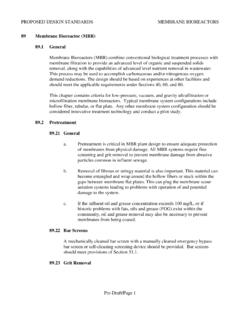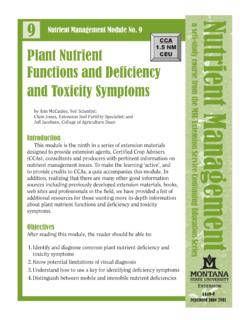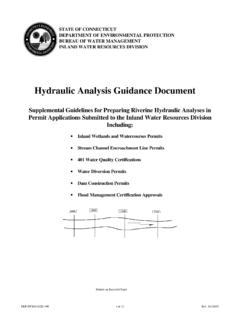Transcription of GUIDELINES ON NUTRITION LABELLING - Home | …
1 Adopted 1985. Revisions 1993 and 2011. Amendment 2003, 2006, 2009, 2010, 2012 and 2013. Annex adopted 2011 and revised 2013 GUIDELINES ON NUTRITION LABELLING CAC/GL 2-1985 PURPOSE OF THE GUIDELINES To ensure that NUTRITION LABELLING is effective: In providing the consumer with information about a food so that a wise choice of food can be made; in providing a means for conveying information of the nutrient content of a food on the label; in encouraging the use of sound NUTRITION principles in the formulation of foods which would benefit public health; in providing the opportunity to include supplementary NUTRITION information on the label. To ensure that NUTRITION LABELLING does not describe a product or present information about it which is in any way false, misleading, deceptive or insignificant in any manner. To ensure that no NUTRITION claim is made without NUTRITION LABELLING .
2 PRINCIPLES FOR NUTRITION LABELLING A. nutrient declaration Information supplied should be for the purpose of providing consumers with a suitable profile of nutrients contained in the food and considered to be of nutritional importance. The information should not lead consumers to believe that there is exact quantitative knowledge of what individuals should eat in order to maintain health, but rather to convey an understanding of the quantity of nutrients contained in the product. A more exact quantitative delineation for individuals is not valid because there is no meaningful way in which knowledge about individual requirements can be used in LABELLING . B. Supplementary NUTRITION information The content of supplementary NUTRITION information will vary from one country to another and within any country from one target population group to another according to the educational policy of the country and the needs of the target groups.
3 C. NUTRITION LABELLING NUTRITION LABELLING should not deliberately imply that a food which carries such LABELLING has necessarily any nutritional advantage over a food which is not so labelled. 1. SCOPE These GUIDELINES recommend procedures for the NUTRITION LABELLING of foods. These GUIDELINES apply to the NUTRITION LABELLING of all foods. For foods for special dietary uses, more detailed provisions may be developed. 2. DEFINITIONS For the purpose of these GUIDELINES : NUTRITION LABELLING is a description intended to inform the consumer of nutritional properties of a food. NUTRITION LABELLING consists of two components: (a) nutrient declaration; (b) supplementary NUTRITION information. nutrient declaration means a standardized statement or listing of the nutrient content of a food. NUTRITION claim means any representation which states, suggests or implies that a food has particular nutritional properties including but not limited to the energy value and to the content of protein, fat and carbohydrates, as well as the content of vitamins and minerals.
4 The following do not constitute NUTRITION claims: (a) the mention of substances in the list of ingredients; (b) the mention of nutrients as a mandatory part of NUTRITION LABELLING ; (c) quantitative or qualitative declaration of certain nutrients or ingredients on the label if required by national legislation. 2 CAC/GL 2-1985 nutrient means any substance normally consumed as a constituent of food: (a) which provides energy; or (b) which is needed for growth, development and maintenance of life; or (c) a deficit of which will cause characteristic bio-chemical or physiological changes to occur. nutrient Reference Values (NRVs)1 are a set of numerical values that are based on scientific data for purposes of NUTRITION LABELLING and relevant claims. They comprise the following two types of NRVs: nutrient Reference Values - Requirements (NRVs-R) refer to NRVs that are based on levels of nutrients associated with nutrient requirements.
5 nutrient Reference Values - Noncommunicable Disease (NRVs-NCD) refer to NRVs that are based on levels of nutrients associated with the reduction in the risk of diet-related noncommunicable diseases not including nutrient deficiency diseases or disorders. Sugars means all mono-saccharides and di-saccharides present in food. Dietary fibre means carbohydrate polymers2 with ten or more monomeric units3 , which are not hydrolysed by the endogenous enzymes in the small intestine of humans and belong to the following categories: Edible carbohydrate polymers naturally occurring in the food as consumed, carbohydrate polymers, which have been obtained from food raw material by physical, enzymatic or chemical means and which have been shown to have a physiological effect of benefit to health as demonstrated by generally accepted scientific evidence to competent authorities, synthetic carbohydrate polymers which have been shown to have a physiological effect of benefit to health as demonstrated by generally accepted scientific evidence to competent authorities Polyunsaturated fatty acids means fatty acids with cis-cis methylene interrupted double bonds.
6 Trans Fatty Acids4: For the purpose of the Codex GUIDELINES on NUTRITION LABELLING and other related Codex Standards and GUIDELINES , trans fatty acids are defined as all the geometrical isomers of monounsaturated and polyunsaturated fatty acids having non-conjugated, interrupted by at least one methylene group, carbon-carbon double bonds in the trans configuration. 3. nutrient DECLARATION Application of nutrient declaration nutrient declaration should be mandatory for all prepackaged foods for which NUTRITION or health claims, as defined in the GUIDELINES for Use of NUTRITION and Health Claims (CAC/GL 23-1997), are made. nutrient declaration should be mandatory for all other prepackaged foods except where national circumstances would not support such declarations. Certain foods may be exempted for example, on the basis of nutritional or dietary insignificance or small packaging.
7 Listing of nutrients Where nutrient declaration is applied, the declaration of the following should be mandatory: Energy value; and The amounts of protein, available carbohydrate ( dietary carbohydrate excluding dietary fibre), fat, saturated fat, sodium5 and total sugars; and The amount of any other nutrient for which a NUTRITION or health claim is made; and The amount of any other nutrient considered to be relevant for maintaining a good nutritional status, as required by national legislation or national dietary guidelines6. 1 See also the Annex for the General Principles for the Establishment of nutrient Reference Values. 2 When derived from a plant origin, dietary fibre may include fractions of lignin and/or other compounds associated with polysaccharides in the plant cell walls.
8 These compounds also may be measured by certain analytical method(s) for dietary fibre. However, such compounds are not included in the definition of dietary fibre if extracted and re-introduced into a food. 3 Decision on whether to include carbohydrates from 3 to 9 monomeric units should be left to national authorities. 4 Codex Members may, for the purposes of NUTRITION LABELLING , review the inclusion of specific trans fatty acids (TFAs) in the definition of TFAs if new scientific data become available. 5 National authorities may decide to express the total amount of sodium in salt equivalents as salt . 6 Countries where the level of intake of trans-fatty acids is a public health concern should consider the declaration of trans-fatty acids in NUTRITION LABELLING . 3 CAC/GL 2-1985 When a voluntary declaration of specific nutrient , in addition to those listed in section , is applied, national legislation may require the mandatory declaration of the amount of any other nutrients considered relevant for maintaining a good nutritional status.
9 Where a specific NUTRITION or health claim is applied, then the declaration of the amount of any other nutrient considered relevant for maintaining a good nutritional status as required by national legislation or national dietary GUIDELINES should be mandatory. Where a claim is made regarding the amount and/or the type of carbohydrate, the amount of total sugars should be listed in addition to the requirements in section The amounts of starch and/or other carbohydrate constituent(s) may also be listed. Where a claim is made regarding the dietary fibre content, the amount of dietary fibre should be declared. Where a claim is made regarding the amount and/or type of fatty acids or the amount of cholesterol, the amounts of saturated fatty acids, monounsaturated fatty acids and polyunsaturated fatty acids and cholesterol should be declared, and the amount of trans fatty acid may be required according to national legislation, in addition to the requirements of section and in accordance with section In addition to the mandatory declaration under , and vitamins and minerals may be listed in accordance with the following criteria: Only vitamins and minerals for which recommended intakes have been established and/or which are of nutritional importance in the country concerned should also be declared.
10 When nutrient declaration is applied, vitamins and minerals which are present in amounts less than 5% of the nutrient Reference Value or of the officially recognized GUIDELINES of the competent authority per 100 g or 100 ml or per serving as quantified on the label should not be declared. In the case where a product is subject to LABELLING requirements of a Codex standard, the provisions for nutrient declaration set out in that standard should take precedence over but not conflict with the provisions of Sections to of these GUIDELINES . Calculation of nutrients Calculation of energy The amount of energy to be listed should be calculated by using the following conversion factors: Carbohydrates 4 kcal/g 17 kJ Protein 4 kcal/g 17 kJ Fat 9 kcal/g 37 kJ Alcohol (Ethanol) 7 kcal/g 29 kJ Organic acid 3 kcal/g 13 kJ Calculation of protein The amount of protein to be listed should be calculated using the formula: Protein = Total Kjeldahl Nitrogen x unless a different factor is given in a Codex standard or in the Codex method of analysis for that food.















